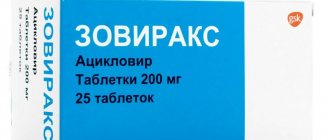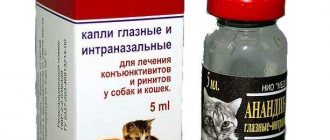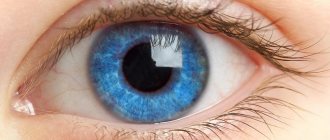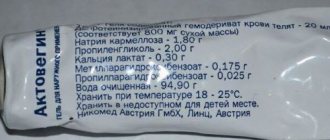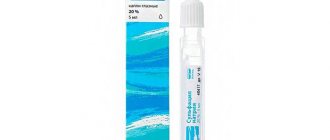Indications for use
Tetracycline ointment is used when a bacterial infection or chlamydia appears in the eyes and eyelids.
The drug helps with the following diseases:
- blepharitis – infectious and inflammatory lesion of the eyelids;
- blepharoconjunctivitis is an infectious and inflammatory disease of the eyelids and conjunctival sac;
- keratitis - inflammatory damage to the cornea, which is accompanied by severe pain and clouding;
- conjunctivitis - infectious infection of the conjunctival sac;
- keratoconjunctivitis – simultaneous damage to the cornea and conjunctival sac;
- meibomitis (hordeolum) – an inflammatory disease of the eyelids affecting the sebaceous glands;
- trachoma – damage to the conjunctiva and cornea due to chlamydial infection;
- eye rosacea – pustular formations accompanied by vasodilation;
- erosive and ulcerative lesions of the mucous membrane of the eyelids.
Tetracycline ointment should only be used for confirmed infection. If it is used for a viral or fungal infection, the disease will intensify and have an unfavorable outcome or complications.
Tobrex or tetracycline ointment
Unlike Tobrex, Tetracycline ointment has more side effects:
- vomit;
- decreased appetite;
- nausea;
- skin rashes;
- disturbances in intestinal function;
- photosensitivity;
- Quincke's edema.
- changes in the mucous membranes of the mouth.
Also, Tetracycline ointment is contraindicated for use during pregnancy and children under eight years of age, while Tobrex is not dangerous for expectant mothers and can be used to treat children starting from one year old.
Note! Tetracycline is not effective against fungal diseases.
Instructions for use
Tetracycline ointment is used topically. Oral use is prohibited; it will cause dyspeptic reactions (nausea, vomiting, change in stool). The thick form is used for the area of the conjunctival sac and eyelids.
To achieve maximum effect, the drug is used prolonged. Therefore, it is used before bedtime. It accumulates in the tissues of the eyelids and conjunctival sac, causing long-term destruction of pathogenic microorganisms.
Squeeze the contents of the bottle onto a cotton swab the size of half a pea.
It is applied to the affected eye area depending on the disease:
- outer side of the eyelid;
- inner side of the eyelid;
- inner corner of the eyes with conjunctivitis;
- skin around the eyes.
If the inner area of the eyelids and eyes is affected, the drug is applied directly from the tube to the mucous membrane, retracting the lower eyelid. After use, clouding occurs and a temporary decrease in visual acuity occurs.
If the drug is prescribed during the day, the use of lenses should be temporarily discontinued. The agent will accumulate in the structure of the contact lenses, causing their damage. The duration of therapy is determined by the doctor during the examination. Most often the period is 1-2 weeks. With trachoma, the period increases to two months. For severe trachoma, the drug is used for more than 3 months.
If the patient has a mild or moderate disease, the drug is prescribed once a day before bedtime. If the disease is more serious, the time intervals are reduced. The product is applied every 2-4 hours. This will prevent the increased proliferation of pathogenic microflora.
For children
There have not been sufficient trials on the use of tetracycline ointment in children. Pediatricians believe that the drug can be used from 1 year of life if the benefits from it exceed the possible side effects.
Do not use products for newborns. In this case, adverse reactions will occur in the form of itching, inflammation, redness, swelling of the mucous membrane and skin around the eyes.
GALAZOLIN
Vasoconstrictor drug for topical use in ENT practice
Active substance
– xylometazoline hydrochloride (xylometazoline)
Release form, composition and packaging
◊ Nasal drops 0.05%
in the form of a colorless or almost colorless, transparent liquid.
| 1 ml | |
| xylometazoline hydrochloride | 0.5 mg |
Excipients: sodium hydrogen phosphate dodecahydrate – 2.5 mg, sodium dihydrogen phosphate monohydrate – 3.68 mg, sodium chloride – 3.3 mg, disodium edetate – 0.2 mg, benzalkonium chloride 50% – 0.2 mg, sorbitol – 20 mg, purified water – up to 1 ml.
10 ml – polyethylene bottles (1) with a built-in dropper and screw cap – cardboard packs. 10 ml – polyethylene bottles (1) with a built-in dropper and a screw cap with first opening control – cardboard packs.
◊ Nasal drops 0.1%
in the form of a colorless or almost colorless, transparent liquid.
| 1 ml | |
| xylometazoline hydrochloride | 1 mg |
Excipients: sodium hydrogen phosphate dodecahydrate – 2.5 mg, sodium dihydrogen phosphate monohydrate – 3.68 mg, sodium chloride – 3.3 mg, disodium edetate – 0.2 mg, benzalkonium chloride 50% – 0.2 mg, sorbitol – 20 mg, purified water – up to 1 ml.
10 ml – polyethylene bottles (1) with a built-in dropper and screw cap – cardboard packs. 10 ml – polyethylene bottles (1) with a built-in dropper and a screw cap with first opening control – cardboard packs.
◊ Nasal gel 0.05%
in the form of a colorless or almost colorless, transparent or slightly opalescent, viscous liquid.
| 1 g | |
| xylometazoline hydrochloride | 0.5 mg |
Excipients: sodium dihydrogen phosphate monohydrate – 3.68 mg, sodium hydrogen phosphate dodecahydrate – 2.5 mg, sodium chloride – 3.3 mg, sorbitol – 20 mg, disodium edetate – 0.2 mg, benzalkonium chloride (50% solution) – 0.2 mg, hyaetellose – 14 mg, glycerol – 40 mg, purified water – up to 1 g.
10 g – polyethylene bottles (1), sealed with an aluminum cap with a pump, with a dispenser and applicator with a safety nozzle – cardboard packs.
◊ Nasal gel 0.1%
in the form of a colorless or almost colorless, transparent or slightly opalescent, viscous liquid.
| 1 g | |
| xylometazoline hydrochloride | 1 mg |
Excipients: sodium dihydrogen phosphate monohydrate – 3.68 mg, sodium hydrogen phosphate dodecahydrate – 2.5 mg, sodium chloride – 3.3 mg, sorbitol – 20 mg, disodium edetate – 0.2 mg, benzalkonium chloride (50% solution) – 0.2 mg, hyaetellose – 14 mg, glycerol – 40 mg, purified water – up to 1 g.
10 g – polyethylene bottles (1), sealed with an aluminum cap with a pump, with a dispenser and applicator with a safety nozzle – cardboard packs.
pharmachologic effect
Vasoconstrictor drug for local use in ENT practice. Alpha adrenergic agonist from the group of imidazole derivatives. In low concentrations it acts on α2-adrenergic receptors, in high concentrations it acts on α1-adrenergic receptors.
When applied topically, it causes a narrowing of blood vessels, which leads to a reduction in swelling and hyperemia of the mucous membranes of the nasopharynx, reduces the amount of nasal discharge, and facilitates nasal breathing with rhinitis.
The effect of the drug begins within 5-10 minutes and lasts for 5-6 hours when used in the form of nasal drops and for 10 hours when used in the form of a nasal gel.
Pharmacokinetics
When the drug is used in recommended doses, xylometazoline is practically not subject to systemic absorption; plasma concentrations are so small that they cannot be determined by modern analytical methods.
Indications
- acute rhinitis of viral or bacterial origin;
- allergic rhinitis;
- acute sinusitis;
- chronic sinusitis in the acute phase;
- hay fever;
- otitis media (to reduce swelling of the mucous membrane of the nasopharynx and restore patency of the Eustachian tube).
Contraindications
- hypersensitivity to the components of the drug;
- atrophic rhinitis;
- angle-closure glaucoma;
- arterial hypertension;
- severe atherosclerosis;
- tachycardia;
- hyperthyroidism (for nasal drops);
- surgical intervention on the meninges (history);
- simultaneous use of MAO inhibitors and a period of 14 days after the end of their use;
- simultaneous use of tricyclic antidepressants;
- pregnancy;
- children up to 6 years of age (for 0.1% nasal drops) and up to 2 years (for 0.05% nasal drops);
- children up to 12 years of age (for 0.1% nasal gel) and up to 3 years (for 0.05% nasal gel).
Carefully _
The drug should be used during lactation, for diabetes mellitus, for angina pectoris III-IV functional class, prostatic hyperplasia, pheochromocytoma (for nasal drops), for hyperthyroidism (for nasal gel).
Dosage
Galazolin in the form of drops 0.05%
prescribed
to children aged 2 to 6 years,
1-2 drops in each nostril 1-2 times a day.
Galazolin in the form of drops 0.1%
prescribed
for adults and children over 6 years old,
2-3 drops in each nostril 2-3 times a day.
Galazolin in the form of nasal drops should not be used more than 3 times a day.
Galazolin in the form of nasal gel 0.05%:
children aged 3 to 12 years,
on average, 1 injection into each nostril every 8-10 hours.
When administered using a dosing device, 1 dose of 0.05% nasal gel contains 50 mcg of xylometazoline.
Galazolin in the form of nasal gel 0.1%:
adults and children over 12 years of age
receive an average of 1 injection into each nostril every 8-10 hours.
When administered using a dosing device, 1 dose of 0.1% nasal gel contains 100 mcg of xylometazoline.
Before using the nasal gel, each time you need to remove the nozzle, then press the dispenser 3-5 times until the gel appears.
Do not exceed the indicated doses. The course of treatment is no more than 3-5 days. The maximum duration of use is 2 weeks.
Local reactions:
with frequent and/or prolonged use - irritation and/or dryness of the nasopharyngeal mucosa, burning and paresthesia of the nasal mucosa, sneezing, hypersecretion of the nasal mucosa; rarely – swelling of the nasal mucosa.
Systemic reactions:
rarely - palpitations, tachycardia, palpitation, arrhythmia, increased blood pressure (especially in patients with diseases of the cardiovascular system), headache, nausea, vomiting, insomnia, weakness, fatigue, drowsiness, blurred vision, allergic reactions (suffocation, vasomotor edema) ; with long-term use and/or when used in high doses - depression, drug-induced rhinitis.
Overdose
There have been no cases of overdose in adults. If too large a dose is used or used incorrectly, ingestion of drops and absorption of the active substance from the gastrointestinal tract may occur. This occurs mainly in children. In this case, a pronounced sedative effect is observed.
Symptoms:
In case of accidental ingestion of the drug (more often in children), tachycardia, arrhythmia, increased blood pressure, drowsiness, confusion, respiratory depression or irregular breathing are observed.
Treatment:
carry out symptomatic therapy.
Drug interactions
Incompatible with MAO inhibitors and tricyclic antidepressants.
When xylometazoline is used simultaneously with other sympathomimetics (for example, ephedrine, pseudoephedrine), the effect is potentiated. This combination should be used with caution.
special instructions
Before use, it is necessary to clean the nasal passages.
Galazolin, like other sympathomimetics, should be used with extreme caution in patients with hypersensitivity to adrenergic agonists, manifested by insomnia, dizziness, tremor, cardiac arrhythmias and increased blood pressure.
The drug should not be used in patients with chronic or vasomotor rhinitis, as they tend to use the drug for longer than 5 days.
Prolonged use of the drug (more than 2 weeks) can lead to secondary dilation of blood vessels and subsequently to secondary drug-induced rhinitis.
The cause of this disease is inhibition of the release of norepinephrine from nerve endings through stimulation of presynaptic α2 receptors.
Recommended doses should not be exceeded, especially in children and elderly patients.
The drug contains benzalkonium chloride, and therefore may cause irritation of the nasal mucosa.
Impact on the ability to drive vehicles and operate machinery
The drug does not affect the ability to drive vehicles and maintain moving machinery if used in the recommended dose and for a short time.
With prolonged use or use in high doses, undesirable effects on the cardiovascular system and central nervous system may occur. If side effects develop, the drug may affect the ability to drive vehicles and machines.
Pregnancy and lactation
Contraindicated during pregnancy.
There is no data on the excretion of xylometazoline in breast milk. It is necessary to prescribe the drug with caution to women during lactation (breastfeeding).
Use in childhood
Contraindications: children under 6 years of age (for 0.1% nasal drops) and up to 2 years (for 0.05% nasal drops); children up to 12 years of age (for 0.1% nasal gel) and up to 3 years (for 0.05% nasal gel).
Conditions for dispensing from pharmacies
The drug is approved for use as a means of OTC.
Storage conditions and periods
The drug should be stored out of the reach of children, protected from light at a temperature not exceeding 25°C. The shelf life of nasal drops is 4 years, nasal gel is 3 years.
The shelf life after first opening the bottle of nasal gel is 12 weeks.
The description of the drug GALAZOLIN is based on officially approved instructions for use and approved by the manufacturer.
The information provided on drug prices does not constitute an offer to sell or purchase goods. The information is intended solely for comparing prices in stationary pharmacies operating in accordance with Article 55 of the Federal Law “On the Circulation of Medicines”.
Found an error? Select it and press Ctrl+Enter.
Source: https://health.mail.ru/drug/halazolin/
special instructions
When treated with antibacterial drugs, patients need to know that tetracycline acts on a certain number of bacteria. If an infection occurs, antibiotic sensitivity testing should be done.
If there is no therapeutic effect during therapy, you should consult a doctor. He will change the drug to an analogue.
Tetracycline ointment causes blurred vision for a short period of time after application. Therefore, it is recommended to use it before bedtime. If the patient drives after application, he should have his vision checked. The same recommendation applies to working with heavy equipment or hazardous chemicals.
During therapy with antibacterial ointment, doctors advise replacing wearing contact lenses with glasses.
If the patient uses lenses intended for more than one day, the drug will accumulate in the porous structure. The lenses will lose their function and become unusable.
Galazolin® (0.1%, 10 ml)
Clear, colorless or almost colorless liquid
Pharmacotherapeutic group
Anticongestants and other nasal preparations for topical use. Sympathomimetics.
ATX code R01 AA07
Pharmacological properties
Pharmacokinetics
The onset of action of xylometazoline occurs within 5-10 minutes and lasts for 10 hours.
When applied to the nasal mucosa, the drug causes local vasoconstriction. Usually not absorbed in clinically significant quantities and does not have systemic effects.
Pharmacodynamics
Xylometazoline is an imidazole derivative with sympathomimetic effects.
Directly stimulates α-adrenergic receptors.
When applied to the mucous membrane, the drug causes vasoconstriction, eliminates swelling and hyperemia of the nasopharyngeal mucosa, and reduces the amount of secretion.
Indications for use
In complex therapy for
– acute rhinitis (runny nose) of viral or bacterial origin
– acute or chronic, recurrent inflammation of the paranasal sinuses
– allergic rhinitis
– acute inflammation of the middle ear – to restore the patency of the auditory tube
Drug interactions
When used together with tricyclic antidepressants and MAO inhibitors, it can lead to an increase in blood pressure. The drug should not be taken while being treated with these medications.
Concomitant use of xylometazoline with other sympathomimetics (e.g., ephedrine, pseudoephedrine) should be avoided due to additive effects.
Storage conditions
Store at a temperature not exceeding 25°C, protected from light.
Keep out of the reach of children!
Shelf life
4 years
The shelf life after first opening the bottle is 12 weeks.
Do not use after the expiration date.
Manufacturer
JSC Warsaw Pharmaceutical,
st. Karolkowa 22/24, 01-207 Warsaw, Poland
Side effects
All drugs belonging to antibacterial groups have side effects. They appear if you use the medicine for other purposes or in a self-prescribed dosage. There are cases of individual intolerance to the drug.
Tetracycline has the following side effects:
- allergic reactions in the form of itching, burning, redness, swelling of the eyes;
- the emergence of pathogen resistance to the ointment when using an excessive dosage or using it for more than 10 days;
- fungal infection of the eyes when using the ointment for more than 10 days or reduced immune function;
- dyspeptic reactions (nausea, vomiting, change in stool);
- increased thrombus formation;
- increased sensitivity to bright light.
If one or more side effects from the list appear, stop using the drug and consult a doctor.
Composition and release forms
Tobrex is produced in the form of drops and ointments.
- Drops - have the form of a transparent solution, sold in bottles of five milliliters.
- Ointment - has a white, uniform consistency, available in tubes of 3.5 milligrams.
The drops contain the following components:
- tobramycin;
- sodium benzalkonium;
- tyloxapol;
- sodium sulfate;
- water;
- boric acid;
- sulfuric acid;
- sodium chloride.
Tobrex ointment belongs to the group of aminoglycosides. Antibiotics of this group are used to treat inflammatory processes that cause microflora sensitivity to the drug. The ointment contains:
- tobramycin;
- petrolatum;
- chlorobutanol;
- paraffin in liquid form.
Analogs
When treated with Tetracycline ointment, there may be no effect. The reason is bacterial resistance or the presence of microorganisms that die under the influence of another medicinal substance.
If the effect of treatment does not occur within 2-3 days, the drug is replaced with an analogue:
- Erythromycin ointment;
- Tobrex;
- Vigamox;
- Tsiprolet;
- Bactroban.
More details about analogues can be found here
All drugs on the list are broad-spectrum antibiotics, highly effective, and have a small number of contraindications and side effects.
Contraindications: children under 8 years of age and
It is prohibited to use Tetracycline ointment for:
- intolerance to the main active ingredient;
- the presence of a reaction to similar antibiotics;
- fungal infections.
Use with caution:
- with renal and liver failure;
- for gastric ulcers;
- in a state of leukopenia;
- for the treatment of children under 8 years of age;
- in the treatment of pregnant and nursing mothers;
- in the presence of documented allergic reactions to general antibiotics.
Tetracycline ointment is available in two dosages - 1% and 3%. In ophthalmology, only a lower content of the main active ingredient is used. The use of 3% of the drug for the treatment of eye diseases can lead to allergic reactions, burns and other consequences.
Find out what leads to the development of Fuchs syndrome by following the link.
During pregnancy, the drug is prescribed with caution.
Temporary loss of visual fields or what is eye scotoma.
Reviews
Ekaterina Fomenko: I often get conjunctivitis, so I periodically use antibiotics in the form of ointments and drops. The doctor advised applying Tetracycline ointment before going to bed. The effect is observed the very next day. This is important because I work at the computer for a long time and my eyes get tired quickly.
Svetlov Denis: I recently suffered from a bacterial eye infection. Streptococcus was detected, the doctor recommended drops and tetracycline ointment before bed. The disease quickly went away, no negative reactions to the medicine appeared.
Yartseva Ekaterina: After my daughter went to kindergarten, she developed frequent conjunctivitis. The doctor said that they are bacterial in nature. He advised me to use Tetracycline ointment before bed. The discharge quickly stopped, but sometimes I notice that my eyes turn red after applying the ointment.
Shelf life and storage
The shelf life of Tetracycline ointment is 3 years. After this, you must throw away the tube if it has not been completely used. If you use expired antibacterial ointment, adverse reactions appear in the form of itching, redness, swelling, and inflammation.
Store medications in a dark space, for example, in a closet. It is undesirable for the packaging to be exposed to direct sunlight. The air temperature should be no more than 20 degrees.
Tetracycline ointment is an effective antibacterial drug for the appearance of purulent-inflammatory eye lesions. The product should be used for a course of no more than 10 days. Otherwise, microorganisms will become resistant to the active substance. Before using the drug, you should consult a therapist; the ointment does not work on all groups of pathogenic microorganisms.
h1: Tetracycline eye ointment title: Tetracycline eye ointment - instructions, price, reviews
Author's rating
Author of the article
Alexandrova O.M.
Articles written
2031
about the author
Was the article helpful?
Rate the material on a five-point scale!
( 9 ratings, average: 3.89 out of 5)
If you have any questions or want to share your opinion or experience, write a comment below.
Overdose
There is no data on overdose of tetracycline ointment.
Tetracycline ointment three percent has a pasty, translucent yellow consistency with a specific odor. Available in aluminum tubes 10-15 g.
It is recommended to store in a cool place.
This article about the drug “Tetracycline ophthalmic ointment” is an informational version, which is an addition to the official medical instructions for the use of the drug. Before using the ointment, you must obtain medical advice and carefully read the instructions approved by the manufacturer.
The information provided should not be a guide for independent use of the ointment. Remember that only a doctor can prescribe or cancel any medication.
Tetracycline ointment
